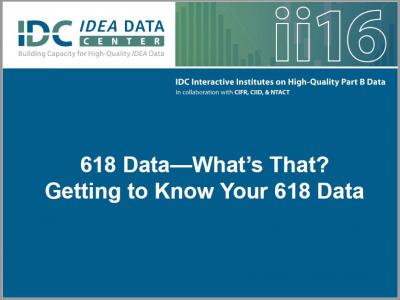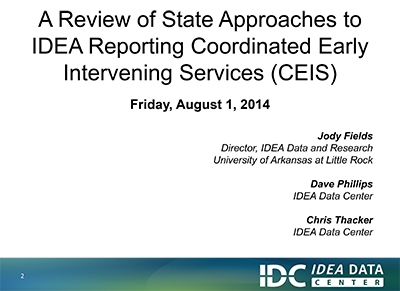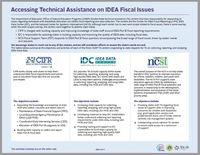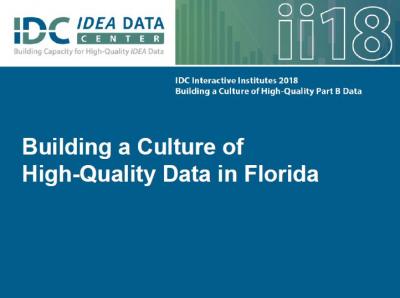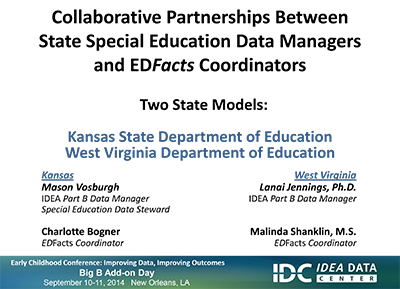Archived Resources
The Resource Library houses tools and products that were developed by IDC, developed with its collaborators, or submitted by IDC stakeholders. Search and filtering tools are available to help users navigate through the library.
Archived Resources 1 - 7 of 41
Format: Presentations
618 Data—What’s That? Getting to Know Your 618 DataHave you heard these terms 618, 616, EDFacts, EMAPS, file specifications, OMB-MAX, GRADS360, Data Quality Reports? Do you understand what they are referencing? Do you want to gain a higher knowledge of these terms? Participants in this presentation learned more about IDEA data reporting requirements in relation to the 618 data collections. They also learned about data quality considerations and tools states can use when going through the data collecting and reporting procedures.
Format: Presentations
A Review of State Approaches to IDEA Reporting Coordinated Early Intervening Service (CEIS)IDEA allows, and sometimes requires, LEAs to use funds provided under Part B of IDEA for CEIS for students who are not receiving special education services. There are multiple data collection and reporting requirements associated with the use of these funds for CEIS. IDC staff review how a diverse subset of states and their LEAs are working to meet those requirements. Both aggregate and student-level reporting approaches are reviewed.
Format: Reference Materials
Accessing Technical Assistance on IDEA Fiscal IssuesThis flyer is meant to help states better understand the three TA centers that are responsible for responding to issues regarding IDEA fiscal reporting and data collection: IDC, CIFR, and NCSI .The flyer contains, a chart with each center’s objectives and activities that are related to IDEA fiscal data.
Format: Recordings
Annual Report to Congress on Implementation of IDEA WebinarThe webinar featured the purpose and history of the Annual Report to Congress on the Implementation of the Individuals with Disabilities Education Act, its current organization and content, links to the report and its data sources, and suggestions for how participants can use the report. The webinar was designed so that participants would have a greater understanding of why it is important to work to improve the quality of IDEA-related data by seeing how the U.S. Department of Education uses IDEA data to meet an annual statutory requirement to report to Congress;. In addition, it was designed to help participants become familiar with a key resource on state and national IDEA data and related information and prompt them to think about how they might use the resource.
Format: Presentations
Building a Culture of High-Quality Part B Data – Florida and New JerseyThis session highlighted Florida and New Jersey as presenters. They told their states' stories of how they have created a culture of high-quality data.
Format: Guides, Papers, and Reports
CEIS Practice GuideThe CEIS Practice Guide provides two scenarios each for voluntary CEIS and comprehensive CEIS. Each scenario describes an LEA’s implementation of voluntary or comprehensive CEIS and how the LEA or state could track the amount LEAs reserved for voluntary or comprehensive CEIS, the activities conducted using IDEA funds for voluntary or comprehensive CEIS, the target group of students, and ongoing student-level data about special education services. IDC and CIFR collaborated to develop the practice guide.
Format: Presentations
Collaborative Partnerships Between State Special Education Data Managers and EDFacts Coordinators: Two Models-Working Together to Make a DifferenceThe presentation outlined the collaborative partnerships between the Part B data manager and EDFacts coordinator in two states--West Virginia and Kansas. The discussion included a range of topics from collaborating on data collection and verification at the LEA level to SEA EDFacts submissions. The presentation included time for other Part B data managers to share strategies for successful submission of their 618 data through EDFacts.


